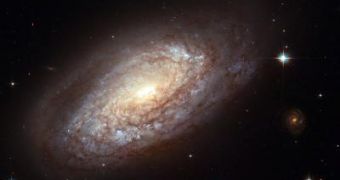NGC 2397 is just another spiral galaxy presenting prominent dust lanes along its arms; older stars in its central regions and newly forming stars in the spiral arms are shown blue in this image. The galaxy is located about 60 million light-years away from Earth, however the Hubble Space Telescope is still able to produce high enough resolution images of it, so that individual stars can be observed in the active star formation region, but not only.
Amongst some of the individual stars in NGC 2397, Hubble's Advanced Camera for Surveys captured the image of the SN 2006bc supernova explosion, during the brightness increase phase. Professor of Astronomy at Queen's University Belfast, Stephen J. Smartt is conducting a long project in which he observes massive exploding stars, namely supernova explosions, thus he requested the images taken by Hubble to be used in his study.
Even now, astronomers have no idea what kind of stars explode at the end of their lives and what is the lowest mass a star can have before exploding as a supernova. Thus, when a new supernova explosion is discovered in a galaxy in the vicinity of the Earth, the researching team looks for previous images of the photographed spot, in hope to find the star that produced the explosion. When the star is found, then they can proceed to calculate what type of star exploded and its mass, based on the brightness experienced in the few years before.
So far, only six of such stars have been identified before they exploded. According to the study conducted at Queen's University, even stars with masses only seven times larger than that of the Sun may end their lives into supernovae. On the other hand, there is no clue to suggest that massive stars may collapse and form black holes during a supernova explosion.

 14 DAY TRIAL //
14 DAY TRIAL //